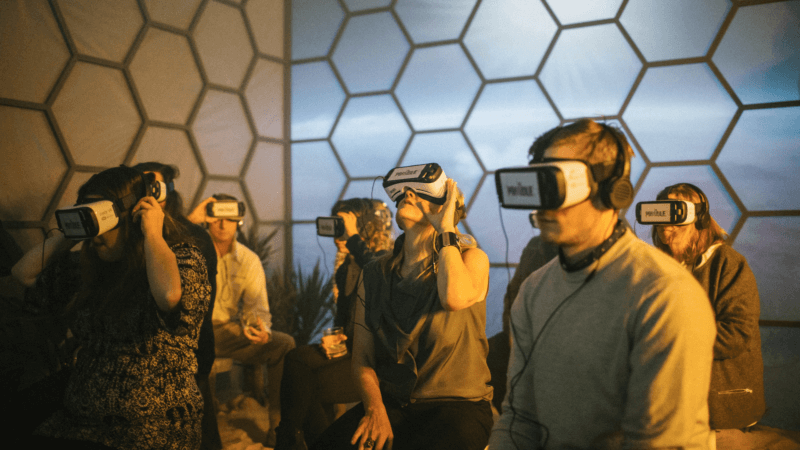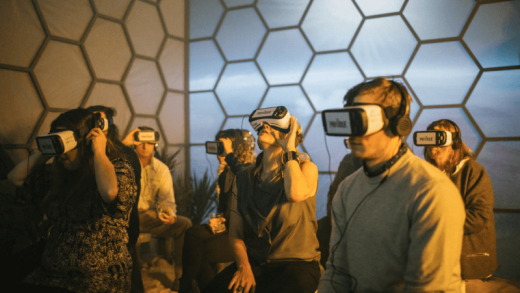How marketers are wrestling with virtual reality’s adoption issue
VR alone may not yet offer brands the scale they seek, but thanks to location-based VR, VR-based filmmaking and AR, VR can still be valuable.

Virtual reality has yet to gain mainstream traction, but it has maintained its grip among marketers. The way marketers are approaching the medium has changed, however.
A year after Facebook’s Oculus, HTC and Sony each released premium-quality VR headsets, though, sales have reportedly failed to exceed single-digit millions. And research firm Forrester has said that VR is not ready for marketers. That has left marketers wrestling with how to get their VR experiences around people’s faces — or whether they should invest in creating those experiences in the first place.
“2016 was when everyone was saying VR is a new, exciting medium that we can use to tell brand stories and engage audiences. Now we’re like, ‘Where’s the audience?’” said Julia Sourikoff, executive producer of VR at production firm Tool.
Compounding matters, the broader availability of VR’s sibling medium, augmented reality — through mobile apps like Snapchat and investments in AR development platforms by Apple, Facebook and Google — has risked cannibalizing VR in its crib.
The obstacles facing VR however, may actually be the medium’s saving grace.
Less noise, more signal
“Upfront everybody wanted to do something in VR but weren’t sure what that thing would be. They loved the buzzword of VR,” said Amy Small, global head of VR at visual effects company Framestore.
Without winning mass adoption, VR has lost some of that buzz. That’s a good thing. In place of a constant, unintelligible hum, marketers have gained some clarity into the role of VR and its opportunities.
For example, Sourikoff has encountered an increase in the number of companies’ research-and-development organizations internally, using VR as a cost-effective way to prototype new products. Tool recently worked with a major auto brand to help it design a new vehicle. In the past, the brand would have paid millions of dollars to construct the physical car. Instead it developed a VR version “for pennies on the dollar,” said Sourikoff.
In addition to thinking about how they can use VR internally, brands are putting more thought into how to best use it externally.
Small said that the question now is, “Who are we going to try to go after?” If a brand is seeking mass appeal, it oftens opts for a simpler execution, such as a 360-degree video that would be more widely available. And if a brand has a narrower target audience in mind that overlaps with those most likely to be interested in VR, an experience within Oculus’s Rift or HTC’s Vive headsets makes more sense. However, answers to this question can raise other, larger questions.
Location-based VR
The biggest danger to VR is that people’s first experience with the medium disappoints: The headset fogs up, an experience dizzies them into delirium, or they expect an immersive experience and instead encounter nothing more than a 360-degree video. This danger poses a dilemma for marketers who are forced to reconcile how not to sacrifice quality nor scale.
Wyndham’s recent work with its agency, Isobar, illustrates how marketers are able to puzzle out the problem. Last year the hotel brand created a VR experience in which people could tour the brand’s properties in Hawaii, Chicago and elsewhere.
“It’s essentially a photo-realistic vacation simulator, so that people can see what Wyndham properties look like and what their vacation might be like before they go on vacation, thus helping sell the vacation packages,” said Leigh Christie, director for North and South America of Isobar’s NowLab, a research-and-development division of the Dentsu Aegis Network agency.
To ensure that the immersive experience would showcase its properties in the best light and wow potential customers, Wyndham developed the campaign for HTC’s Vive headset, which must be powered by a high-end PC. The device not only offers superior picture quality to more accessible headsets like Samsung’s Gear VR and Google’s Cardboard, but it also enables people to move around within the virtual environment, albeit while tethered to the computer.
However, in its decision not to compromise on quality, Wyndham risked compromising the campaign’s reach. It’s unclear how many Vive headsets are on the market, but in the first quarter of 2017, only 95,000 were sold, according to SuperData Research. To address the issue, Wyndham has adopted a distribution strategy popular among brands developing VR experiences: location-based VR. Similar to a car brand showing off a new model at an auto show or a hardware company hosting a pop-up shop to demonstrate its products, Wyndham has arranged areas at its sales events for people to put on a headset and virtually tour its hotels.
“Location-based VR seems to be continuing to accelerate right now. And the reason for this is pretty simple: to get the best experience, the gear is really expensive. And that’s going to remain true for a very long time,” said Christie.
However, brands’ VR experiences do not necessarily need to be experienced within virtual reality.
VR filmmaking
The lack of VR headsets may mean fewer people are able to experience a brand’s VR campaign, but that doesn’t mean brands can’t expose a lot of people to it. A process called mixed-reality capture has opened up the world of VR filmmaking. Similar to shooting videos with computer graphics, mixed-reality capture can record a two-dimensional video of a person or multiple people moving through a VR experience, combining the physical protagonist(s) and the virtual world.
Cond
é Nast Entertainment used mixed-reality capture to shoot an original series for Facebook’s Watch tab called “Virtually Dating.” In an update to the traditional dating-show format, each episode of the series sets two people on a blind date, but instead of the pair eating at a restaurant or playing miniature golf, they don VR headsets to go on dates set in outer space or at the bottom of the ocean.
In addition to increasing its reach, converting a three-dimensional VR experience to a two-dimensional video reduces the effort required to produce the experience. In these contained experiences, brands don’t have to worry about instructing people on how things work. They don’t have to think through potential pitfalls if a person veers from the set storyline. And blemishes can be touched up in post-production “after you’ve pulled the mixed-reality video because now what we’re talking about is just pre-rendered film,” said Sourikoff. “You can add voiceover and special effects. You can actually take a little bit more editorial control.”
And since the VR experience is three-dimensional, brands have full freedom in deciding how to capture it in two-dimensional video form.
“You can move the camera anywhere you want,” said Christie. He added, “You can put on a headset, take your controllers, go into a virtual-reality setting and pick up a virtual camera off the table and start filming whatever it is you’re looking at from whatever angle you want, to not only make a 2D video but also to make 360[-degree] videos.”
But videos aren’t the only ways that VR experiences can be repurposed for broader reach.
VR development, AR execution
These days, it’s nearly impossible to talk to people about virtual reality and not have the conversation reorient itself around augmented reality. I began the conversations with both Sourikoff and Christie by asking what are clients’ level of interest in VR. And both Sourikoff and Christie immediately invoked AR in their responses.
“It’s impossible to not talk about AR, which is now the darling of the advertising world in a lot of ways,” said Sourikoff. “What’s exciting about AR is the same thing that was exciting about VR early on, which is the opportunity for a mobile-driven experience and to scale it to a wider audience.”
Thanks to the popularity of Snapchat’s Lenses, the recent rollout of Apple’s ARKit and Google’s ARCore, AR is a more immediate opportunity than VR for brands looking to create campaigns that can impress a lot of people. And while it seems that AR has risen to overshadow VR, the relationship between the two media may be more complementary than competitive.
Many VR experiences are built using game development platforms like Unity. But the 3D objects developed with this software do not need to be limited to 3D environments, like VR. “When you develop content in Unity for virtual reality, you can re-deploy that content in augmented reality. So in that sense, they’re highly, highly compatible,” said Christie.
Marketing Land – Internet Marketing News, Strategies & Tips
(40)



